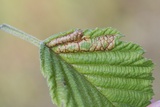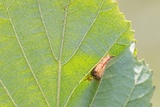Caloptilia elongella (Linnaeus, 1761) Species
Last modified: Dec. 10, 2025, 1:40 p.m.
A fairly common species throughout Belgium.
Details
- Classification
- Family: Gracillariidae > Subfamily: Gracillariinae > Tribus: Gracillariini > Genus: Caloptilia > Species: Caloptilia elongella
- Vernacular names
- Bruine elzensteltmot (NL), Pale red slender (EN), Große Erlen-Blatttütenmotte (DE)
- Synonyms
- Caloptilia signipennella (Hübner, 1796)
- First mention in Belgium
- De Sélys-Longchamps E. 1844. Énumération des insectes Lépidoptères de la Belgique. — Mémoires de la Société royale des Sciences de Liége 2: 1–35. On page 25 (as signipennella). view page
- Status
-
Native
Distribution
Caterpillar
Greyish green with brownish head capsule.
Mine
First instars make a short serpentine mine on the upperside of a leaf that later broadens into a whitish blotch. Later instars contract the mine into an elongated tube. The free-living instars roll a leaf margin downwards and fasten it with white silk.
See also gracillariidae.net and bladmineerders.be.
Cocoon/pupa
A transparant, yellow-shining cocoon.
Bionomics
Mines with caterpillars can be found from March to October, without a clear seasonal maximum. Pupation in a transparent, yellow-shining cocoon, most of the time at the underside of a leaf and at the leaf margin. The species hibernate in the adult stage. Moths take shelter in cracks in trees, with a preference for pine trees. They hide during the daytime but come to light.
Flight periods
The adults fly in two generations a year in June, and again from late August till April of the next year.
Observed on
- Host plant (species):
- Alnus glutinosa
The larvae feed mainly on Alnus glutinosa, more rarely on Alnus incana.






